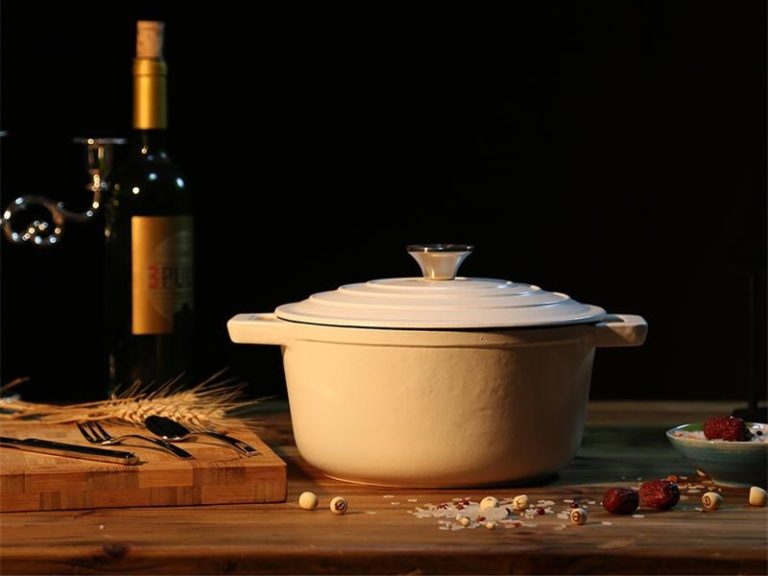
Enameled Cast Iron Cookware Use&Care
1.Before First Use
Enjoy unboxing your new purchase! (And make sure to remove the labels and packaging.)
Wash your Enameled Cast Iron Cookware in warm, soapy water ; then rinse and dry thoroughly.
2.HEAT SOURCE
The Enameled Cast Iron Cookware is compatible with gas, ceramic, electric, radiant, halogen, and induction heat sources.
<> When using the Enameled Cast Iron Cookware on a gas stove DO NOT let the flame extend beyond the sides of the cookware.
<>DO NOT let the handles extend over another burner or over the edge of the range.
<>Always use hot pads or kitchen gloves when removing cookware from the oven or stove top.
3.ENAMEL COATING
Please be considerate of the enamel coating on your cookware, to ensure maximum life expectancy.
<>DO NOT PRE-HEAT. This will result in cracks and later peeling of the enamel coating. Your choice of liquid, oil, fat or butter should completely cover the base before heating begins. Small cracks may occur if cookware is heated without moisture in cooking vessel. DO NOT heat olive-oil to temperatures above 160°C, discolouring may occur.
<>DO NOT heat empty cookware or allow it to boil dry. Either may cause permanent damage to the enamel.
<>DO NOT fill hot cookware with cold water or plunge into cold water as thermal shock damage to the enamel may occur.
<>Cracks & peeling due to incorrect use of the cookware will void the warranty.
<>Use of metal utensils will result in marks on coating, and might cause cracks or dents when used.
<>CAUTION: Dropping or hitting the cookware against a hard surface can cause the cookware to chip or break.
4.HEAT SETTING
<>High heat is NOT recommended. Your cookware efficiently distributes and maintains the heat.
<>Select ONLY low to medium-low heat for best results. Once the cookware is hot most cooking can be continued on lower settings.
<>High heats should only be used for boiling water for vegetables or pasta, or for reducing the consistency sauces or stocks.
High heats should NEVER be used to pre-heat cookware before lowering the heat for cooking. Cast iron retains heat so well
that if overheated in this way it will contribute to poor cooking results, sticking and discolouration of cooking surfaces.
Enamel surfaces are permanently damaged by this misuse.
<>NEVER LET COOKWARE BOIL DRY ON A STOVE, AS IT IS A SAFETY HAZARD.
<>Enameled Cast Iron cookware is oven safe to 250°C(480℉).
<>DO NOT place a hot cookware directly on your countertop, place hot cookware onto a heat resistant surface, such as trivets
and cooling racks.
5.AFTER USE
<>Cool the cookware for a few minutes before washing in hot soapy water by hand. Rinse and dry thoroughly.
<>If there are food remains, fill the pan with warm water and leave to soak for 15 - 20 minutes, then wash in the usual way.
<>Soft abrasive pads or brushes can be used to remove stubborn residues. Do not use metallic pads, or abrasive or acidic
cleaners as these will damage the enamel coating and cause glossy outer layer to dull.
<>The Enameled Cast Iron Cookware is NOT suitable for use in a dishwasher , hand-washing is recommended.
<>Never store away cookware when still damp. Store cookware in dry cupboards or an airy space away from kitchen steam.
<>Season the edges. Enamelled cast iron doesn't need to be completely seasoned like a Preseaoned cast iron cookware.
However, there is a thin border of exposed cast iron along the rim of the pot and lid that needs to be seasoned in order to protect the surface. To season,use a paper towel to rub a light coating of neutral, high smoke-point oil(Canola Oil is a desirable option) on the edge, where the cast iron is exposed.
6.MISUSE
<>DO NOT use the cookware in a microwave.
<>DO NOT use electric or hand held beaters or mixers as permanent damage to surfaces will occur.
<>DO NOT cut food directly on the surface of the cookware.


